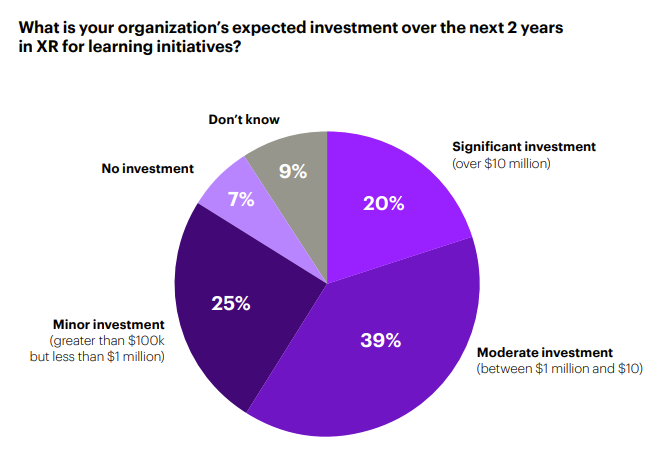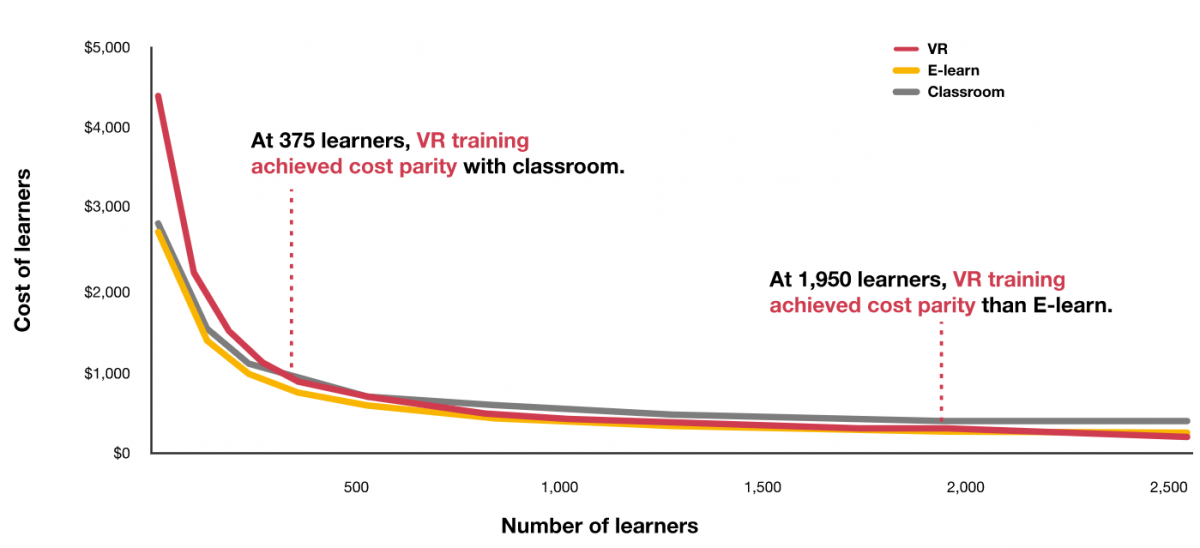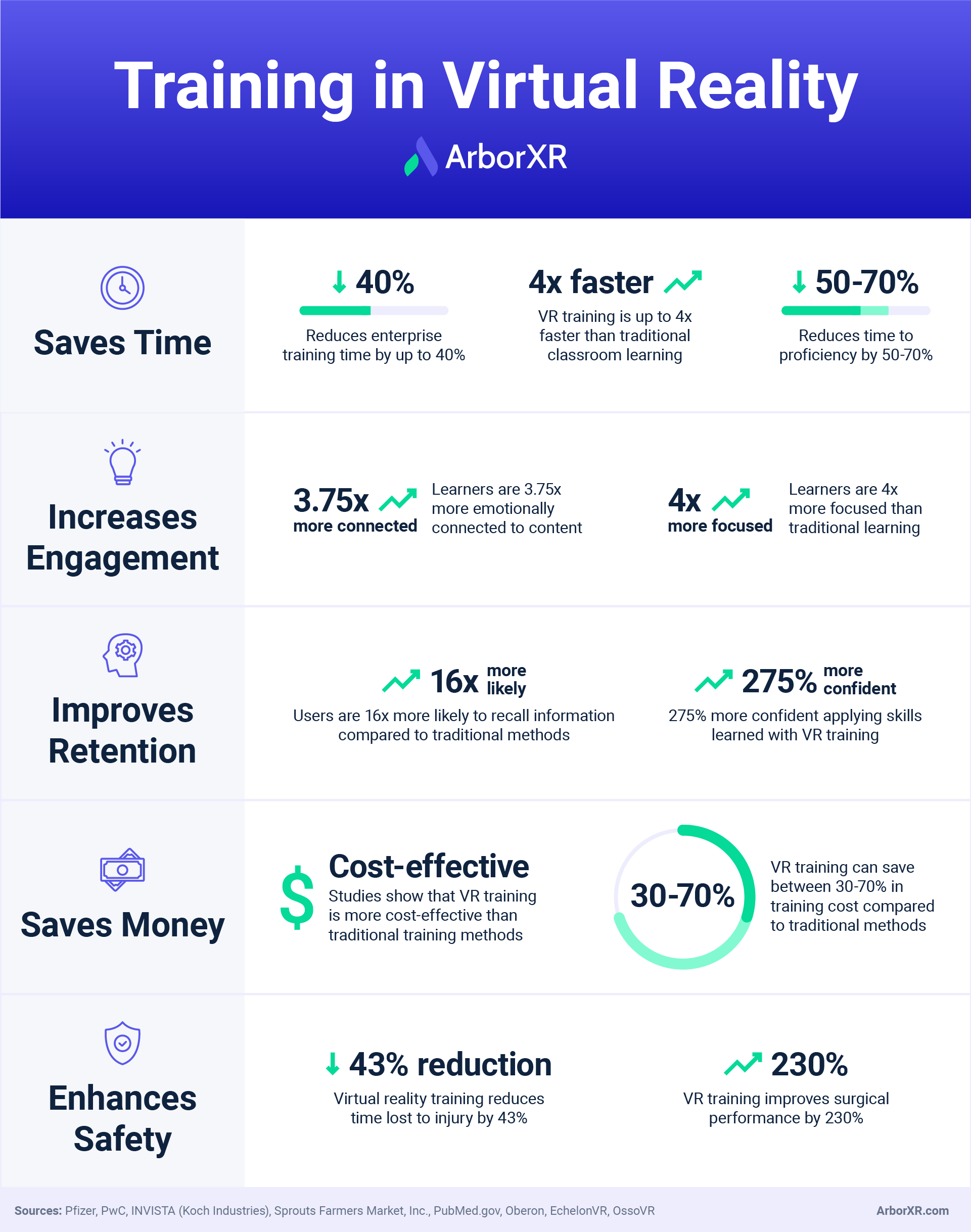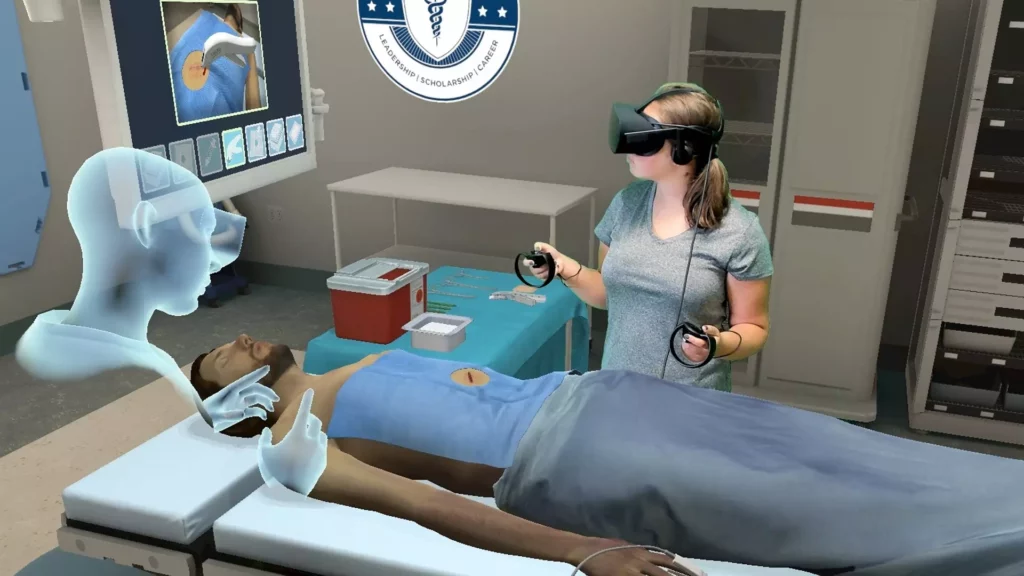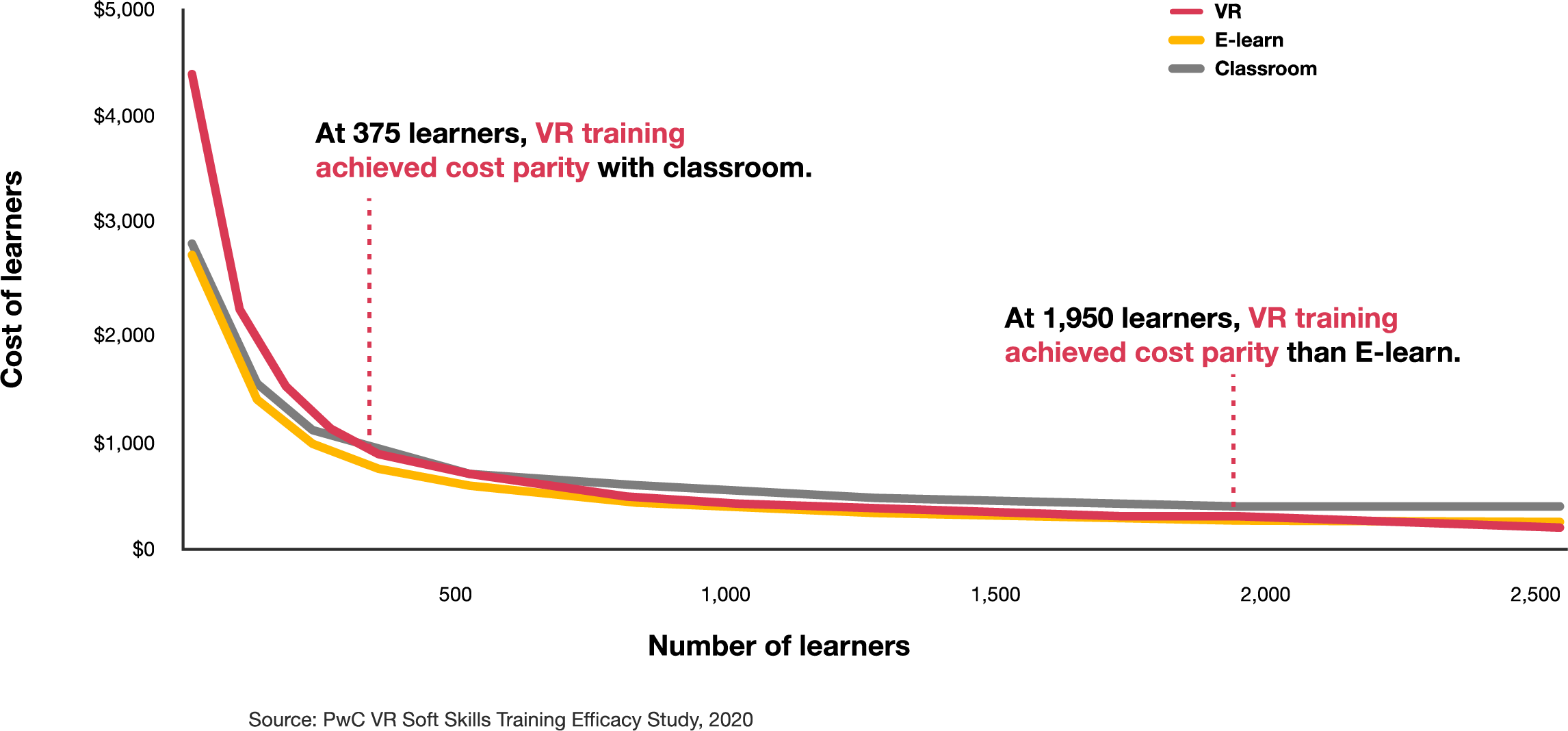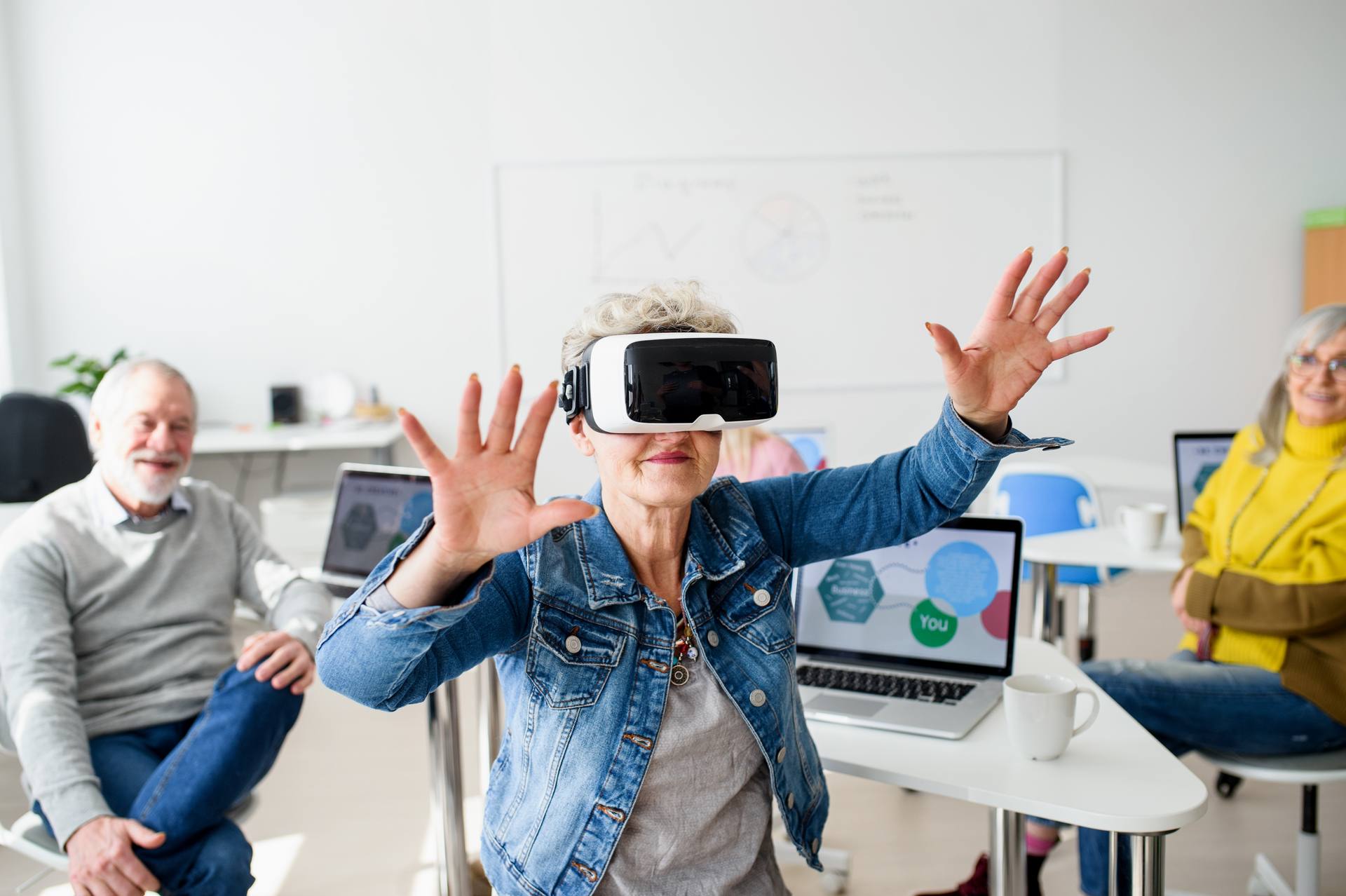The Impact of Immersive Learning on Staff Training
Wondering how immersive learning benefits teams across industries? Compelling research is quickly mounting up. Countless studies from world leaders like Accenture and PWC have shown that immersive training (using XR technologies) can improve knowledge retention, increase employee confidence, boost engagement, and even reduce training times.
In fact, PWC says that immersive training helps learners complete training up to four times faster while ensuring they retain the knowledge they gain for longer. It’s little wonder that our own research found “employee training” to be one of the main use cases for companies adopting XR.
As skill shortages continue to cause significant problems for growing companies, traditional training methods are failing to deliver the right results. It’s time for companies to upgrade their approach to professional development with immersive, hands-on experiences.
Immersive Learning Benefits: The Science of Success
Traditional training solutions are problematic. Human beings rarely hold onto the information we get from books and old-fashioned videos or lectures for long. In fact, studies show that we only remember about 30% of what we read and 20% of what we see on average. However, we retain around 90% of the knowledge we gain from hands-on experience.
Immersive learning benefits employees across industries by positioning them in virtual, interactive environments where they can experiment with different scenarios and practice skills without risk. With virtual, augmented, and mixed reality solutions, companies can tap into the benefits of experiential learning, unlocking the power of “learning by doing.”
Immersive environments stimulate the brain through visual, auditory, and even kinesthetic cues (with haptic feedback), fostering deeper engagement with educational content, enhancing muscle memory, and accelerating skill mastery.
According to the latest stats from market leaders, immersive education improves learning effectiveness by up to 76%, increases learner confidence by up to 275%, and even promotes more cost-effective training. After all, immersive solutions offer companies a virtual solution they can share with countless team members, all without hiring specialist training teams.
Immersive Learning Benefits: The Impact on Training
Although companies that want to unlock immersive learning benefits must overcome initial challenges, the outcomes are incredible. Our research found that companies struggle with initial expenses and onboarding strategies, but in the long term, they benefit from quicker, more effective, and less costly training initiatives.
Here’s how immersive learning benefits modern teams.
Accelerating Learning with Immediate Feedback
Most companies today don’t have the time or resources to give every employee a human mentor while they learn. A lot of corporate skill development happens through online classes and courses – meaning team members miss out on valuable feedback.
Extended reality platforms, combined with AI, can give team members feedback in real-time, without the need for human educators. Systems can track an employees movements and decisions, and share insight advice on how they can improve their skills.
In aviation, for instance, trainees can practice complex maneuvers in a controlled setting, receiving instant performance assessments. In healthcare, medical students can use simulations to practice complex procedures, and receive feedback in real-time.
For instance, GE Healthcare transformed radiography training with VR, offering healthcare professionals a virtual environment where they could interact with three-dimensional scanners, and access real-time support from an AI assistant.
Enabling Fully Personalized Learning Experiences
Traditional educational experiences are often very “one-size-fits-all”. Immersive learning benefits employees by giving them a more personalized, dynamic experience. With metaverse as a service and dedicated software tools, companies can build unique training programs for each employee and upgrade them over time based on performance data.
They can embed artificial intelligence into training scenarios, giving each employee a virtual mentor that learns about their needs, weaknesses, and strengths and adapts accordingly. Immersive learning platforms even give users access to dashboards and reports where they can monitor their performance across tasks and invest more fully in their own education.
For instance, the Bank of America created a virtual “Academy” designed for onboarding new employees, with custom training solutions for each team member based on their role.
Boosting Engagement with Interactivity and Gamification
Engagement often suffers in traditional training environments. Team members are easily distracted by other tasks when they’re watching videos and reading content. In some cases, courses are forgotten about entirely – leading to low completion rates.
Immersive learning benefits teams by implementing interactive elements and gamification into learning environments. For instance, students can earn points and badges for their accomplishments or compare their performance to colleagues on a leaderboard. This increases engagement and helps employees to more actively “enjoy” the training experience.
For example, Walmart has been using virtual reality training for years now to help employees prepare for complex customer service scenarios with interactive challenges – like managing a Black Friday rush or dealing with an irate buyer. Greater engagement leads to better knowledge retention, meaning businesses spend less time “retraining” employees.
Immersive Learning Benefits for Collaborative Teams
Collaboration is often crucial in any business environment, and employees need help learning how to interact effectively with their colleagues. Unfortunately, in the world of hybrid and remote work, it can be difficult to facilitate face-to-face interactions between peers.
Immersive learning addresses this issue, by allowing companies to create group learning environments in a virtual world. For instance, with Microsoft Mesh, companies like Accenture have created onboarding and training environments where teams can work together on developing new skills, and share knowledge in real-time – regardless of their location.
Immersive solutions even improve on-the-job training. For instance, with augmented or mixed reality glasses, employees in a manufacturing plant can request real-time insights from subject matter experts, who can share documents, annotations and comments in an instant.
Transforming Soft Skill Training
Countless companies have already discovered that immersive learning benefits companies in developing technical skills. In the aviation industry, companies are using XR to enhance flight training simulations. In engineering, firms like Intel use HTC VIVE headsets to train team members on reducing electrical accidents within corporate environments.
Even in healthcare, companies like the NHS and UC Berkley are using extended reality to help professionals practice procedures and surgeries in a controlled environment.
But immersive training isn’t just great for hard skill development. It can assist companies in enhancing soft skills too. For example, Verizon uses VR to train call center employees on how to handle difficult customer interactions, improving communication skills and emotional intelligence.
By enhancing both soft and hard skill training, XR prepares all kinds of team members to excel in their roles. PWC even found that VR-trained employees were 275% more confident in applying what they learned compared to those trained through traditional methods.
Reducing Risks and Costs in Training
On top of all the immersive learning benefits mentioned above, extended reality solutions also reduce the risks and costs associated with traditional training. Immersive solutions provide employees with realistic, risk-free environments where they can practice and perfect their response to potential hazards. In manufacturing, for instance, Autoliv China uses mixed reality to help team members learn how to repair potentially dangerous machinery.
The US fire department uses extended reality training programs to help prepare firefighters to navigate burning buildings and avoid threats when responding to emergencies. Team members can learn faster in safe environments that don’t put their health or wellbeing at risk.
Beyond that, immersive learning benefits companies by allowing them to offer comprehensive training programs to team members across locations with minimal costs. Businesses can avoid the costs and environmental impact of asking team members to travel to a specific location for a hands-on workshop. They even reduce the amount of downtime for crucial machines, as users can experiment with digital twins rather than real-world products.
Embracing Immersive Learning Benefits: Next-Gen Education
In the future, immersive learning will continue to revolutionize the corporate training landscape. The opportunities are only growing as vendors experiment with new hardware, from upgraded MR headsets (like the Apple Vision Pro) to cutting-edge smart glasses and haptic wearables.
Educational software is also becoming more sophisticated and accessible, with flexible development platforms, tools for creating digital twins (like Varjo Teleport), and integrated AI solutions – like those built into the Android XR platform.
Companies that embed these technologies into their learning strategies can reduce costs, improve knowledge retention, and enhance employee performance faster than ever before. Ready to dive in? Read our guide to implementing immersive training into your business. Alternatively, learn how to boost the ROI of immersive learning solutions here.
Quelle:

